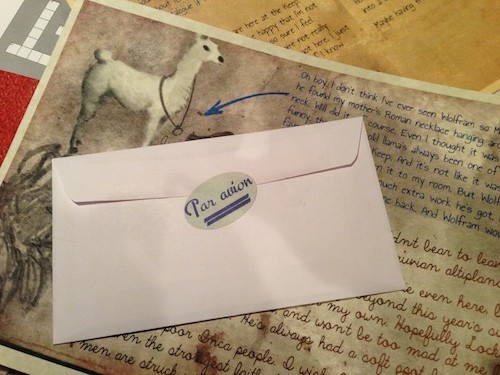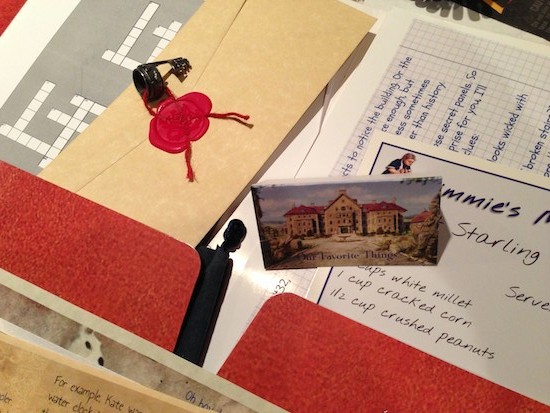 Review Fix chats with Karen Bellinger Wehner (Founder and CEO, ThunderSnow Media, The Time Tribe Producer, Creative Director, Writer) and Lucas JW Johnson (Founder and CEO, Silverstring Media Inc, The Time Tribe Executive Producer, Lead Game Designer, Writer) about The Time Tribe, a point and click time travel adventure game with a surprising amount of depth. In this interview, the two developers discuss the title’s inspiration and how they’d like to see the game remembered.
Review Fix chats with Karen Bellinger Wehner (Founder and CEO, ThunderSnow Media, The Time Tribe Producer, Creative Director, Writer) and Lucas JW Johnson (Founder and CEO, Silverstring Media Inc, The Time Tribe Executive Producer, Lead Game Designer, Writer) about The Time Tribe, a point and click time travel adventure game with a surprising amount of depth. In this interview, the two developers discuss the title’s inspiration and how they’d like to see the game remembered.
Review Fix: What was the inspiration for the game?
Karen Bellinger Wehner: It’s a bit unusual, I think, since my formal training is in academics. I’m an archaeologist and historian, with a PhD in Anthropology and fifteen years of experience in museum- and university-based research and education. But my undergraduate degree is in Literature, and I’ve always loved writing and storytelling. The Time Tribe began as a story that came to me back in 2006, as I was finishing a Post-Doctoral Fellowship in London. I had such vivid imagery in my head of these four kids, and a mysterious mansion full of stuff from all over the world, with an elevator that could take them traveling through time to the amazing places that so fascinated me. I was at a transition point and decided I wanted to share my passion with a younger audience, and on a more casual and immersive basis than higher education allows.
Another strong (if kind of weird) external influence was the American Girl Doll series, comprised of dolls from different cultural heritages such as Native American, African American, European Colonial, Mexican American, etc. Each doll comes with her own storybook, outfit and accessories meant to teach kids a bit about the respective cultural traditions, and how they have contributed to American culture overall. Being toys, the educational elements are there, but definitely secondary to the fun of playing with them. I always thought it was amazing that no one had done something similar but with a world culture basis, and in a way to appeal to boys as well as girls. So that’s what I set out to do.
Review Fix: What was the development process like?
Bellinger Wehner: Definitely a long and winding road. Initially it was just me, walking around with a story pitch, and vague ideas about how to create a fun and interactive experience from it. I spoke to anyone and everyone I could pin down in media, game design, and edtech. I had settled on some kind of game when I finally connected with Lucas, in an unusually successful round of internet professional ‘’dating.†He quickly sold me on the point-and-click adventure game concept and we began a truly great collaborative working partnership that’s been instrumental in getting The Time Tribe from concept to working product. As first-time game makers, we were lucky to get input and advice from some really smart and generous people, most notably David Langendoen, of Electric Funstuff in New York.
In terms of the actual design and development process, it was pretty nerve-wracking, to be honest. Despite its sexy image, I’ve learned that making a game is no picnic, and there’s no shortage of blood, sweat and tears shed behind the curtains. But once we connected with the right development partners in Dubit, Ltd., it always felt like we were moving forward in the right direction, even if sometimes we were just crawling along.
Lucas JW Johnson: There’s a lot of back and forth between Karen and me, in all parts of the development. My job is often to take Karen’s vision and translate that into what it might look like in a game, blocking out a lot of the quests and puzzles and in-game storylines, and then sending that back to Karen for discussion, re-writes and the like, making sure it stays true to the goals, the intended voice, and the long-term narrative plans, while keeping a close eye on the experience of the young player. We want the game first and foremost to be great entertainment, and a great story.
Review Fix: Do you think there are any games this one directly draws its influences from?
Johnson: What I’ve really enjoyed about designing The Time Tribe is that it’s a bit of a mixture of great influences. Obviously traditional point-and-click adventure games like Monkey Island are a big influence, along with the text-based interactive storytelling of Fallen London, but really it’s old games like Carmen Sandiego that drive the passion – those games that were educational but never felt educational. The ones I loved playing as a geeky kid. The Time Tribe is really for my younger self.
We then built in what we see as the best elements of successful kids’ virtual worlds, the stuff we know today’s kids can happily play for months on end – the free exploration of vivid worlds, the fun minigames, the customization that you can share with friends, etc., of Club Penguin, Webkinz, Moshi Monsters, and other games of that ilk.
Review Fix: With a ton of other online games out there, how will this one captivate gamers differently?
Johnson: First and foremost, it’s about the story. Kids love Harry Potter, all the way up to the final book in the series, where the stakes are dire. Kids are smart. They love a good story, and they don’t need things to be dumbed down for them. Few other games for this age group provide that. We’ve heard from so many beta players who love our story, and they all want to know what happens next. Each episode will present its own story arc that will move the main storyline forward significantly, but meanwhile, little clues to the overarching mystery of the Time Tribe and their rivals will unfold for players on an everyday basis, if they’re willing to look for it.
The way the story has been designed also allows for different player styles. Those who just want the puzzles and minigames and customization can get through the game without having to think too much about the characters and their backstories. But the game quests might grab them, and pull them in deeper. And for those players who do want to know more, there are many story levels deeper they can go. Exploring optional side quests and journal entries, secret notes and a serial comic unlocked in the game allows players to delve deeper into the story world, its characters, and the mysteries that surround them.
Most exciting for me personally are the optional physical elements, which include short stories, letters from the characters, journal entries, and real world activities that players can receive in premium mailer packages which go even deeper into the stories and characters in ways that casual games simply cannot (see attached images of optional real world elements).
 Bellinger Wehner: While seconding everything Lucas says, I’d say there are still more ways in which The Time Tribe is pretty unusual. Plenty of games take inspiration from the past or other cultures to create appealing environments, but it’s usually window dressing, with a random selection of decorative elements people associate with a given civilization (such as mummies, pyramids, and pharaohs in Egypt). There’s not much in our story world that doesn’t have a good reason to be there, and specifically in the way that it is. So you won’t find any generic vases in the game, but you will find a Chinese Qin vase and an Indus Valley bowl vase. Each plays a critical role in the game and its underlying story. It’s not immediately evident in the current, prologue episode, but as the story plays out, players will come to see that we’ve painstakingly chosen each object, setting, and scenario to play a key role in the overarching narrative. And part of the unique fun of playing this game is piecing that puzzle together.
Bellinger Wehner: While seconding everything Lucas says, I’d say there are still more ways in which The Time Tribe is pretty unusual. Plenty of games take inspiration from the past or other cultures to create appealing environments, but it’s usually window dressing, with a random selection of decorative elements people associate with a given civilization (such as mummies, pyramids, and pharaohs in Egypt). There’s not much in our story world that doesn’t have a good reason to be there, and specifically in the way that it is. So you won’t find any generic vases in the game, but you will find a Chinese Qin vase and an Indus Valley bowl vase. Each plays a critical role in the game and its underlying story. It’s not immediately evident in the current, prologue episode, but as the story plays out, players will come to see that we’ve painstakingly chosen each object, setting, and scenario to play a key role in the overarching narrative. And part of the unique fun of playing this game is piecing that puzzle together.
Review Fix: What’s your favorite element of the game?
Bellinger Wehner: For me it would have to be the nuances we’ve built into the game choice structure, which contribute directly to our ultimate goal of building cross-cultural awareness and fostering empathy for different beliefs and ways of life. Each time travel episode is built around a core conflict that players will have the chance to examine from both sides, and will eventually have to choose one over the other. Such choices impact both the immediate narrative, and how other game characters will relate to them going forward. Rather than just offering choices for the sake of having them, our goal is to present cross-cultural interactions with all the complexity they deserve, rather than falling back on stereotypical identifications of ‘good’ guys vs ‘bad’ guys. So, for example, we can show that in a colonial situation, the colonizers were probably not entirely evil, the colonized were not entirely victims, and cross-cultural influence is always a two-way street, even in a situation where one group is dominated by another. The game is replayable, so it’s possible to check out the implications of either choice, firsthand.
There’s also our integrated Charity Portal, which allows players to donate game currency to current real-world causes related to the issues they will encounter in the game. We’re currently partnered on this with The Harry Potter Alliance on general human right issues, and World Leadership Foundation on trying to close the ‘digital divide’ that increasingly will define poverty in coming years.
Johnson: As a storyteller first and foremost, it would have to be the depth of the options players have to explore the story. Every character has unique conversations they can have with every other character, conversations that explore who they are, where they’ve come from, what they want. None of it’s strictly necessary to play through the game, but the more you explore, the more you try things playing as different characters, with their different viewpoints, the more you’re rewarded.
Review Fix: What are your long-term goals for this title?
Bellinger Wehner: We’ve got a Season One story arc that currently includes 12 episodes, and covers all of the earth’s major geographical and cultural regions. At the very least, we hope to secure a partnership or sufficient funding to produce all of Season One. But limited only by the scope of human history, we’d gladly see it go on, and on, and on…. Stay tuned!
Review Fix: How would you describe this game in a sentence?
Bellinger Wehner: It’s an awesomely fun time travel adventure, based on real history and archaeology, where you can take your role on the great stage of human history, and have a chance to concretely address the problems of the past that persist in today’s world.
Review Fix: Who do you think will enjoy the game most?
Bellinger Wehner: The game was designed primarily to appeal to tweenage kids (8-13) and their families. But just a few weeks post-beta launch, we’re finding that the deep storyline, high production values, and creative puzzles and mini-games that depend on interesting factoids gleaned in the game, as well as logic and dexterity, are appealing to a more broad category we might call ‘’young-at-heart.’’ In other words, we’re finding – quite unexpectedly – that our target player appears to be anyone who enjoys a great story, poking around in the more interesting corners of our shared human history, and quality adventure gaming generally.


Leave a Reply